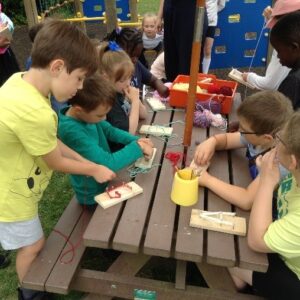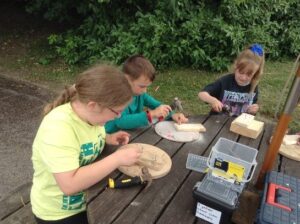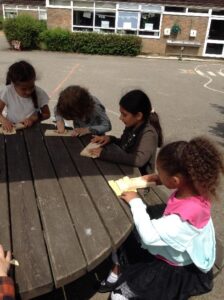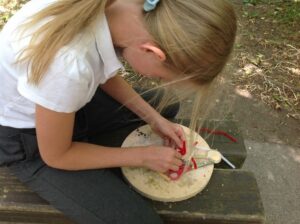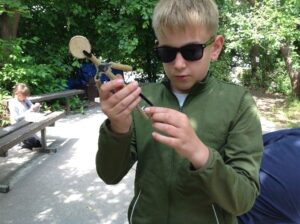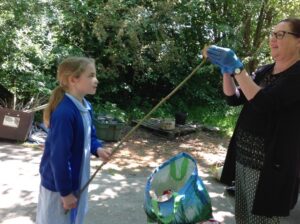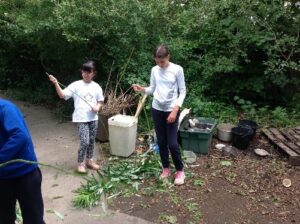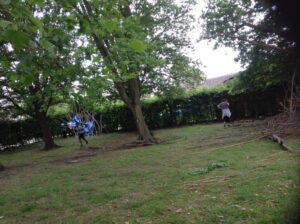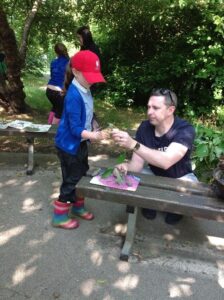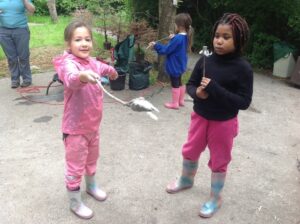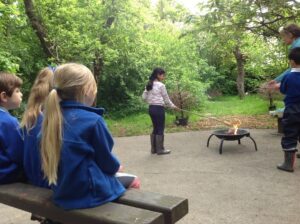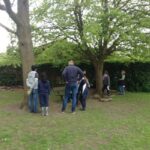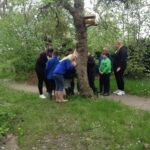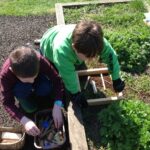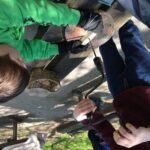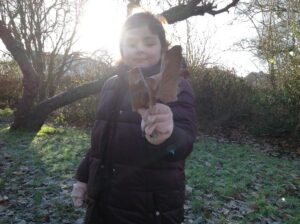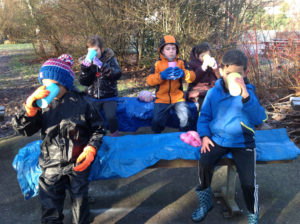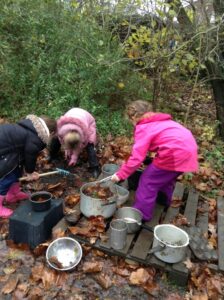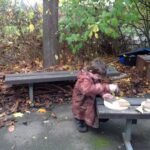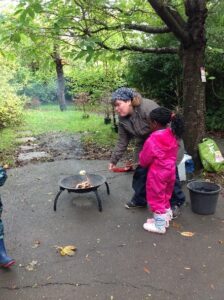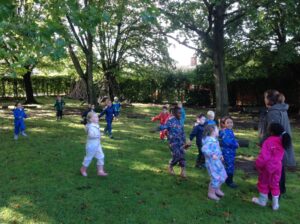Subject Lead: Ms S Burns
- Forest School School Development Plan (260.77KB)
- Forest School at The Ryde School (127.73KB)
Outdoor and Adventurous Week 2024
Nursery
Hapa zome with Herbs
We chose some herbs and petals and put them on a circle of muslin cloth.
First we used a wooden hammer to hit the herbs – to get the printing to work. We then tried it using a real hammer.
Look at the pretty patterns we made and we could smell the herbs too.
Willow peeled and then wound with wool
We chose a stick of willow harvested from the Willow tunnel. Then we used our fingers to peel the green bark. We then used coloured wool to wind around the stick to make our own design.
Reception
Windmills / Pin Wheels
Using recycled paper, we created designs for our pinwheel.
We then chose a stick of willow harvested from the willow tunnel and carefully using a hammer and nail we fixed a bead and our designed paper onto the willow stick.
Year 2
Wood key rings
Using hazel or willow wood, we used sand paper to smooth surface. We then used the hand drill with a small diameter ‘bit’ to create a hole for the key ring fixing.
Finally, we used pens suitable for wood and decorated the key ring with our own designs.
Year 3
Wood necklaces/ medallions / spinners
Using birch wood cookies, we learned a safe technique to create a hole with a palm drill.
We used naturally dyed twine or wool to thread the necklaces/medallions and decorated them with unique designs and patterns.
Year 5
Bat Workshop
Roger, a volunteer with the Herts and Middx Bat Rescue Group, came to give us a workshop about Bats.
He showed us outlines of the sizes of different species of bats, the pipistrelle which are commonly found in the UK are much smaller compared to the largest species of bat, Fruit Bat, which live in South America and Africa.
We also learnt about what bats eat: mosquitoes and midges. He told us that there are some bats which live near to Hatfield Park as they are seen flying over to the river and lakes to get food. Roger bought in a pipistrelle bat which had to be rescued for us to see.
Woodland characters
A range of natural resources were provided, along with palm drills and a hand drill for creating holes in birch wood cookies, corks and sticks, in order to make our own woodland character for our animation project.
We used different methods to join the resources together and finally decorated our character with features.
Below are some of the characters we created.
Year 6
Fire lighting skills
After recalling the 3 points on a Fire Triangle (heat, fuel and oxygen) and a safety talk, the pupils learnt the ‘Respect’ kneeling position when lighting a fire to help keep them safe.
Different methods of lighting fires were discussed and the Fire Steel and strikers were demonstrated.
After teasing out their ball of cotton wool, they practiced a technique to create a spark which would then ignite the cotton wool.
This skill was new to many of the pupils and they showed perseverance in practicing the skill and were delighted when they managed to cause the flame on the cotton.
When the cotton wool was alight, they stood back to watch for when the fire was safely out.
Outdoor and Adventurous Week 2023
Nursery
Willow peeled and then wound with wool
We chose a stick of willow harvested from the Willow tunnel then we used our fingers to peel the green bark.
We then used coloured wool to wind around the stick to make our own design.
Reception
Windmills / Pin Wheels
Using recycled paper, we created designs for our pinwheel. We then chose a stick of willow harvested from the Willow tunnel and carefully using a hammer and nail we fixed a bead and our designed paper onto the willow stick.
Year 2
Hammer and nails with wool weaving
Using reclaimed wood from a pallet we used sandpaper to smooth the surface of the wood.
We then used a hammer to fix nails into the wood to create the first letter of our name.
We then chose a coloured wool and wove the wool around the nails to create the letter.
Year 3
Woodland necklaces/ medallions/ spinning toys
Using birch wood slices, we learned safe technique to create a hole with a palm drill or hand drill.
We used naturally dyed twine and wools to thread through the holes for our necklaces, medallions, bracelets or spinning toy. Finally, we decorated them using coloured pens with unique designs.
Year 4
Ron Weasly Willow Wands and other woods
Using harvested willow from the tunnel, coppiced hazel, pruned plum and elder branches, we used a safe technique to whittle and remove the bark from the stick with a peeler.
Afterwards we cut the length of wand using a pair of loppers. Later we customised our wands by decorating them.
Year 5
Woodland characters
A range of natural resources were provided along with palm drills and a hand drill for creating holes in birch wood cookies, Tent pegs were used for creating holes in elder sticks to make our own woodland stick person to star in a movie.
Year 6
Fire lighting skills
After a safety talk and looking at the different types of fire steel, Year 6 teased out their cotton wool and used a scallop shells as a mini fire pit.
After getting into the ‘Respect’ position in front of their log, Year 6 were ready to have a go to create a spark with a fire steel.
They chose a fire steel and practised a technique to create a spark which would then light the cotton wool. If they found it easy to do, they supported and gave encouragement to those who were finding it trickier.
When the cotton wool was alight they stood back , always watching to make sure the fire was safely out and then water was added to ensure it was really safe.
Exploring Forest School at The Ryde School
Year 6 sessions
Summer term 2023
During Forest School sessions pupils have had the opportunity to learn new tool skills, as well as revisiting those activities enjoyed in past years. The photos below show a selection of the range of activities during the term.
- Learning how to use new hand tools like Japanese saw and pruning saw, loppers, secateurs, bit and brace, hand drill and peeler skills on green willow.
- Our campfires are always an exciting and yummy time .
- Skills in sculpting with clay and creativity using willow.
- Play with mud and water has been popular too.
- Branches and tarpaulins used to create dens
- Problem solving team work to rescue soft animals stuck in the branches
Some of the pupils have supported Year 2 visits to ‘The Dell’ this term and assisted with the litter picks to keep the community space safe and tidy for everyone the animals who live there.
Year 2 sessions
Summer term 2023
During Forest School sessions the children have chosen new and challenging activities to explore and engage with as well as revisiting those enjoyed in past years. The photos below show a selection of the range of activities during the term.
- Learning how to use new hand tools like hand drill and practice hammer skills in creative activities of Hapa zome
- Exploring the wild area and getting close up to trees
- Our campfires are always an exciting and yummy time
- The pretend marshmallows in clay after the fire are good for role play too
- Skills in sculpting with clay and natural objects have unique results
- Den building and learning how to put up the tipi as shelters
- Play with mud and water is popular too
The class continue to extend their knowledge of plants and animals in the school grounds and are getting very good at bird identification and recognising bird calls.
It was lovely to have parents and carers join us for a Forest School session when the children were able to share some of their favourite activities with their grown ups.
The pupils have enjoyed three trips to The Dell woodland next to school this term – each time they have done a litter pick to help keep the space clean and safe for people in the locality and the animals who live there.
Year 5 sessions
Spring term 2023
The pupils have been working toward their Junior Forester Award which has been developed by the Royal Forestry Society as part of the Queens Jubilee Green Canopy project.
During their Thursday afternoon sessions, the children have completed different challenges to build on skills and knowledge from Forest School in previous years.
They also had time to explore and engage in their own choice of new activities, as well as revisiting those enjoyed in past years.
In January the weather was cold and icy, this provided opportunities to explore the properties of ice in the mud kitchen area.
Also working together to use the tarpaulins, pegs and clamps to join on branches to create their own dens for play and keeping dry when it rained during a session.
In the hammock, during the low level climbing of the trees and by creating swings, the children explore different ways of moving and the sensations that result, as well practice knots and consider how to keep each other and themselves safe during the activity.
Extending their knowledge about plants and animals in the school grounds was part of the sessions, as well as developing their creative and artistic skills especially in sculpting with clay and in woodwork, learning how to use new tools e.g. hand drill and the bit and brace.
The class look forward to the campfires we have and are getting very good at toasting their marshmallows for smores.
The first of the challenges for the Forester Award was to identify possible ‘Risks’ in the Wild area and talk about how those risks could be reduced (control measures) if visitors were to come to our school ground. Working in small groups the pupils identified risks and control measures were suggested.
Another challenge was to identify six trees in the school grounds. As there were no leaves on the deciduous trees, the children used twig identification sheets to help them identify the trees through bark patterns and buds, as well as any remaining brown leaves on the ground under the trees whose shape would help with the identification.
The Park Ranger from Panshanger came to visit us and answered questions the pupils had about her work. The class took her on a tour of the grounds and she assisted in the class planting of thirty tree saplings along the hedge and behind the new Nursery area.
Another of the challenges was completed in small groups, was to create an animal habitat in the school grounds. The pupils chose to make insects habitats for ladybirds, stag beetles, worms and woodlice.
Towards the end of the Spring Term parents and carers joined the class for session to see the results of some of the challenges for the Award and take part in an activity to work out the age of the mature trees on the field and celebrate with the class the achievement of their Forester Award.
A birds nest with newly hatched birds , in the trunk of one of the old apple trees was of great interest.
The measurement of trees to approximate their age and calculate the year in which they were planted was a team effort.
All the pupils who had taken part in the six different challenges received a certificate for their Junior Forester Award.
Year 3 sessions
Spring term 2023
During Forest School sessions the children have chosen new and challenging activities to explore and engage with as well as revisiting those enjoyed in past years. The photos below show a selection of the range of activities during the term.
The weather started off cold and icy which provided opportunities to explore properties of ice in the mud kitchen and effects on the leaves and enjoy hot chocolate outdoors at snack time to help keep warm.
The children explore different ways of moving and the sensations that result – in the hammock, low level climbing of the trees, using the story circle logs to re-enact stories they have been told in class.
The class look forward to the campfires we have and are getting very good at toasting the marshmallows.
They continue to extend their knowledge of plants and animals in the school grounds and are getting very good at bird identification.
They have been further developing their skills especially in sculpting with clay and in woodwork, learning how to use a hand drill safely.
After the Willow tunnel had been pruned there was fascination with the soft buds from the willow – which were collected from the withies and later used in potions in the mud kitchen.
The wet weather has allowed muddy puddles to develop in the wild area and have been places the children have chosen to play.
Groups of children have worked together to use the tarpaulins, pegs and clamps to join on branches to create their own dens for play and keeping dry when it has rained during a session.
Towards the end of the term we enjoyed the visit of parents and carers who joined in activities with the whole class.
Year 4 sessions
Autumn term 2023
This term, Year 4 have taken part in weekly forest school sessions. During these sessions we learnt how to keep ourselves safe in the outdoor environment and when using equipment and tools (e.g. hammers).
We have enjoyed activities including:
- Campfire and toasting marshmallows
- Bug hunts
- Clay
- Den building
- Woodwork
Making Christmas wreaths with our parents out of willow and holly.
Autumn term 2022
During Forest School sessions the children have chosen new and challenging activities to explore and engage with as well as revisiting those enjoyed in past years. They have been further developing their skills especially in sculpting with clay and in woodwork. They continue to extend their knowledge of plants and animals in the school grounds and are getting very good at bird identification. The photos below show a selection of the range of activities during the term
Reception Class sessions
Autumn Term 2023
This term at Forest School, Reception Class have been learning about the different seasons that we have during the year. They have learnt how to get dress into their forest school clothing independently. Every week they have learnt how to safely explore different areas of the school grounds, that children do not have access to during playtime, allowing them to use and explore new senses.
Using their senses, they felt the cherry tree. Reception Class have done this every week and have found that the bark can feel wet, warm, slippery, slimy, dry, or bumpy depending on what the weather is like. They also discussed what happens to the tree: why the leaves are falling off and what is next in the cycle for the cherry tree in the upcoming season.
Reception Class have practised the Forest School safety games and have learnt how to be safe within the forest school area, having an understanding of the boundary’s while having fun.
During the last week of term Reception Class had the experience of a campfire session. Mrs Pedley explained what the children should and should not do during campfire and how to keep safe within the fire circle. Reception Class were exceptional at understanding this and then were able to use these skills a few weeks later at their parent workshop showing their parents\helpers how to cook on the campfire.
October 2022
Reception class have established routines for getting ready to go outside to the ‘Wild Area’ on a Friday morning where we have Forest School.
A theme of how we use all our senses in Forest School, with a different focus each week- sight, hearing, touch, smell, movement and taste, has enabled the children to explore and learn through a range of activities.
The children have learnt a short song to sing at the start of the journey around the school grounds to the Wild Area. Each week we stop to observe the cherry tree outside Nursery to look for seasonal changes and explore with our senses, for example what is the feel and texture of the bark and leaves, the colours and shapes we can see and listen for rustling of leaves in the wind.
The journey continues along the willow edged path and the children have spent time collecting coloured autumn leaves and sycamore ‘helicopter seeds’ around the stage area. When we reach the Apple tree circle at the far side of the field, the children then all join in an action song ‘Kelele’ practising actions to move to when we feel cold.
The children continue their journey along the ‘hedge on the edge’ of the field looking closely for plants or insects hiding in the hedgerow. We have seen spider webs, snails, blackberries and stinging nettles.
Each week when we arrive at the large trees in the Wild Area – we play our safety games of 1,2,3 where are you? and the Stop game.
There are lots of different shape leaves which have fallen off the large trees and acorns to collect during this time too.
We have started to share with the children the names and features of trees and plants we see on the journey to the wild area and have shared pictures of birds which are the house group names, so far we have covered: Robins, Finches and Wagtails.
The children have learnt the boundaries of Forest School and have become familiar with playing safely with sticks and the equipment we have for them to use e.g. hammock, bug hunting, mud kitchen and the brushes and rakes for the leaves have been popular for collecting the fallen leaves.
Photographs are taken each week of some of the different activities during Forest School and some are printed out for the class Forest School book, with some going on the Forest School noticeboard in class too as reminders of some of the plants and animals the children have observed in the school grounds.








































